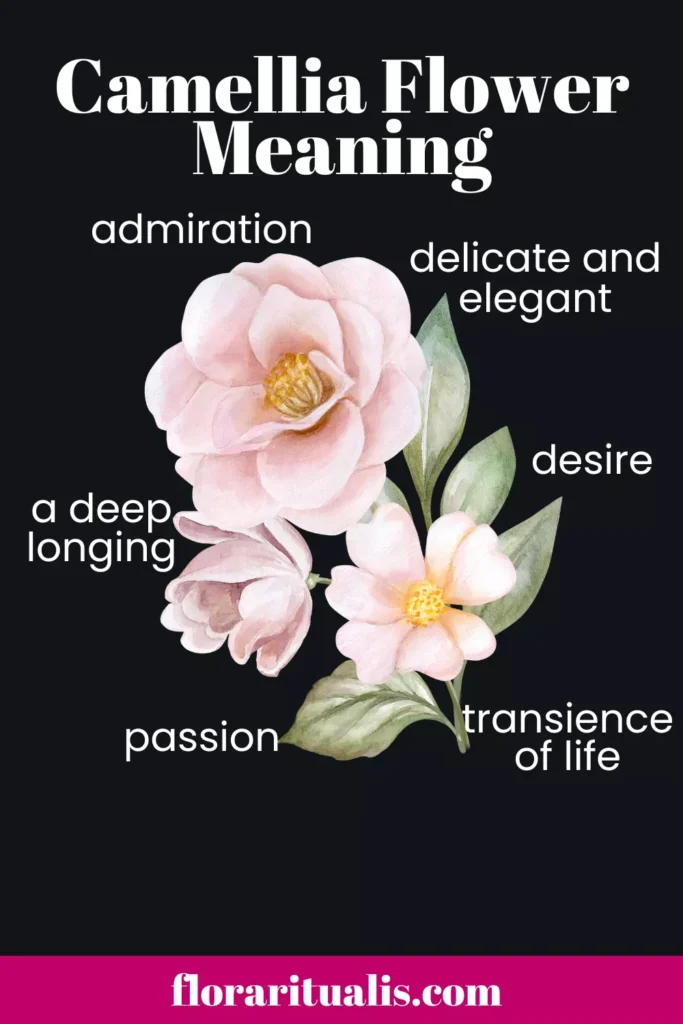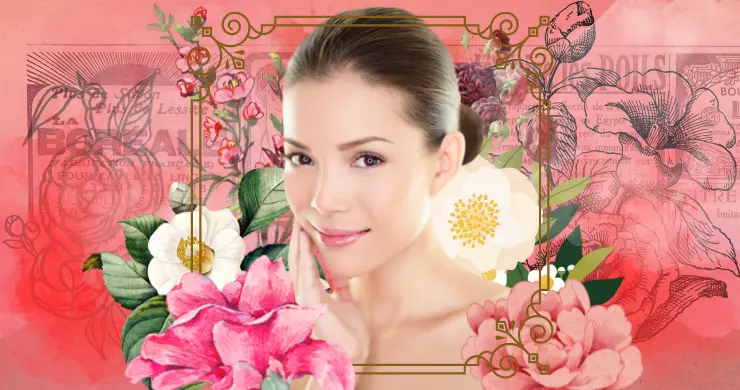The Camellia flower meaning comes to us from the far east. This elegant plant is rich in folklore and history.
The genus Camellia around 82 species but the most domesticated species is undoubtedly the Camellia sinensis.
In this blog we will explore the symbolism of the different Camellia varieties, the history of the flower, its folklore and uses.
What does the Camellia flower symbolises?
The Camellia flower symbolises admiration, desire, a deep longing, delicate and elegant, passion and transience of life. It is also a considered as a good luck gift to a man. The possible powers of this flower is wealth, luxury and prosperity.
Camellia flower colour meaning
The Red Camellia flower symbolises ardent love and being in love.
The White Camellia flower symbolises beauty, perfection and loveliness.
The Pink Camellia flower symbolises desire, a deep longing and a persistent desire.
The Yellow Camellia flower symbolises longing.

Camellia Japonica flower meaning
The Camellia Japonica flower or Unryu means admiration, gratitude, refinement, pity, perfection and unpretending excellence. Just like the Camellia variety it is a good luck gift to a man. Moreover, the different colours of the Camellia Japonica have similar meaning to the Camellia’s general meaning.
Camellia Sinensis flower meaning
The Camellia Sinensis or Black Tea’s symbolic meaning is young sons and daughters. Its possible powers are courage, healing, riches, strength and prosperity.
In order to boost courage and increase strength in ancient times, they would wear a pouch of the Camellia Sinensis as a talisman.
Camellia flower history in Asia
Tea or Camellia Sinensis was believed to be initially eaten rather than drank. In China people would eat tea leaves with shallot and ginger.
In Thailand they would boil the leaves and roll them into a ball then would eat them with salt, oil and garlic.
While in Myanmar the leaves would be eaten as a salad.
The origins of the tea is unknown however villagers cultivated Camellia around 1600 B.C in the region of Sichuan in China.
A Japanese story recalls a priest a who lived in China. He returned to Japan in 815 CE with tea.
When shogun Minamato Sametomo fell ill in 1191, the Buddhist monk Myoan Eisai used tea in order to cure him. Sametomo himself credited his recovery to tea and he became a fervent advocate.
Myoan Eisai therefore planted Camellia Sinensis seedlings on the island of Kyushu.

Camellia Sinesis history and evolution in China
The tea was made into a concentrate and then sealed in earthenware jars. By the late Zhou dynasty around 1100-800 B.C those earthenware jars were signs of a flourishing trade around the Yangtze River.
Around the Confucian Era 517 to 479 B.C tea had a reputation of moderation due to rituals of tea drinking. This was due to the mix of cosmology with social order which was the Confucian practice.
It would further lead to folk-religious practices surrounding tea making and tea drinking in Chinese villagers.
The book entitled Working Rules of Servants which dates around the 1st century BCE described in details buying and preparing tea. Tea was now a popular beverage in China.
Around 479 A.D, tea became a regional trade and this gained the attention of the Chinese Imperial bureaucrats.
This also led to tax a new tax and credit system. It would create a very important fiscal link between the northern and southern kingdom of China.
By the 7th century, Camellia sinensis beverage became the nation drink of China. The drink was so popular that would be used as money and additionally lead to the creation of paper currency.
The Chinese princess Wen Cheng would marry a Tibetan king called Songtsan Gambo in 641 C.E. This would lead to the first introduction of tea in Tibet. They would barter tea to Tibet in exchange for horses.
When the Mongols invaded China it was the first time tea would encounter a setback. Since they were not familiar with the drink they viewed it as unimportant.

It was also during this time the Italian adventurer Marco Polo visited China and was unaware of the cultivation of the plant. When the Mongols were thrown out from China tea resumed its prominence.
Tea would evolve into small cakes this was done in order to prevent it from spoiling. Those cakes were then boiled in water.
During the Song dynasty around 960 to 1279, plum juice was used in tea in order to sweeten it. It was during this period that tea would be powered and replace cakes.
Furthermore, this led to teahouses being common. This offered a place for both social and economical interaction. The activities in teahouses revolved around listening to poetry, cementing business alliances and gossiping.
During the Ming dynasty 1368 to 1644 was when the Chinese learnt how to oxidise the leaves of the Camellia Sinesis. However, it was regarded as inferior to green tea.
The tea harvest was completely controlled by Imperial China. They would assign the work solely to young women and made sure they had their names on their jackets to they would measure the productivity.
Furthermore, they were required to grow their nails as the skin was forbidden to touch the leaf of the Camellia Sinensis.
Camellia flower folklore
In China there is a legend that goes back to 2737 BCE. The legends tells that a blossom from the Camellia fell into a cup of hot boiled water.
This cup belonged to Shen Nong (the Divine Farmer) who was feeling tired, however, after drinking the water with the Camellia flower he became alert and awake.
He noted this discovery on paper and wrote Pen Ts’ao which was a book on medicinal herbs.
A Japanese myths also tells the origins of the Camellia flower.
A very devout follower of the Buddha named Darma had taken a vow to pray without stopping. He prayed for year when one day the Evil One succeeded in overpowering him and putting him to sleep.
When he woke up he felt humiliated and also sad. Consequently he cut off his eyelids and threw them away.
Two plants grew on the spot he had threw his eyelids. Those plants had the ability to dispel sleep.

Name origin
We owe the name Camellia to a Moravian Jesuit who was a traveller in Asia, his name was George Kamel or Camellus.
He introduced the plant from China into Europe around 1639. While returning to Spain with the plant he sought an audience with Queen Maria Theresa.
The plant was presented to the Queen in a pearl vase and two white flowers were also present.
Queen Maria Theresa ran to her husband with the flower. The King found the flower to be beautiful but scentless. However, in spite of the defect the plant would then we cultivated in hothouses of El Buen Retiro and name after George Kamel.
By the mid 19th century the Camellia became one of the most sought after flowers in Europe.
Camellia flower benefits
There are numerous benefits to the Camellia flower in form the form of tea. Lets explore some:
The earliest records of benefits are from the poet Lu Yu in 780, He recorded that tea had the ability to cure constipation, depression, headache and pain throughout the body.
A Buddhist monk called Myoan Eisai believed that tea could prevent paralysis and beriberi. He also noted that tea would stimulate appetite.
The tannins found in tea kills bacteria that are responsible for typhoid, dysentery and cholera. Tannins also passes into breast milk and this might have protected infant from various diseases and improved the mortality rate.
Camellia Sinensis also has antimicrobial properties. In 1923 an army physician recommended soldiers fill their canteens with tea in order to prevent typhoid. It also reduced diarrhea and reduced the rate of infection from influenza.
The leaf of the Camellia Sinensis was also a great way to combat bacteria growth in the mouth.
It is also a great source of minerals calcium, magnesium, iron, zinc, copper, cobalt, potassium and chromium.
Tea aids with the function of the circulatory system thus protecting against cardiovascular diseases.
The Camellia Sinensis leaves when brewed as a tea was an excellent source of antioxidants which may protect against cancer. Several researchers have found that tea drinking women had one third fewer cancer than those who didn’t drink tea.
Other studies have found that tea helps to:
- sharpen the mind
- detox the body
- lessen fatigue
- help with digestion
- strengthen the immune system
- preserve the elasticity of the skin.
Camellia flower magical properties
The magical properties of the plant as previously mentioned revolves around abundance and wealth.
Planting Camellia flowers in your garden is a good way to attract abundance and riches in your life.
It is also a plant that is related to the energies of the divine feminine. Hence, they plant can aid to connect with the divine feminine energies.
The Camellia flower helps in decision making by listening to the wisdom of the Camellia flower we learn how to trust ourselves and our visions.
FAQ Camellia flower
References
Croy, A. (2015). Everyday Life. Routledge. https://doi.org/10.4324/9781315704463
Cumo, C. (Ed.). (2013). Encyclopedia of Cultivated Plants [3 volumes]: From Acacia to Zinnia. ABC-CLIO.
Dietz, S. T. (2022). The complete language of flowers the complete language of flowers: A definitive and illustrated history – pocket edition. Wellfleet Press.
Folkard, R. (1884). Plant lore, legends, and lyrics. Embracing the myths, traditions, superstitions, and folk-lore of the plant kingdom. S. Low, Marston, Searle, and Rivington.
Koehn, A. (2013). Gift of Japanese flowers. Tuttle Publishing.
Nature, color illustrations vol.30: Handbook of nature. (2016). VM eBooks.
Watts, D., & Watts, D. C. (2007). Dictionary of Plant Lore. Academic Press.
Whitehurst, T. (2013). The magic of flowers: A guide to their metaphysical uses and properties. Llewellyn Publications.
Deena Bsingh, a UK-born, Mauritius-raised content writer, is a dedicated explorer of the ancient world’s hidden treasures. Armed with classical studies knowledge and a decade of spiritual immersion, Deena delves deep into the wellspring of ancient wisdom. Her illuminating writings on flower meanings and culinary history are imbued with the profound insights she has gathered on her journey. Through her Medium articles, she guides readers on transformative journeys that bridge the gap between ancient cultures and contemporary consciousness, offering a rich tapestry of understanding that endures through time.

